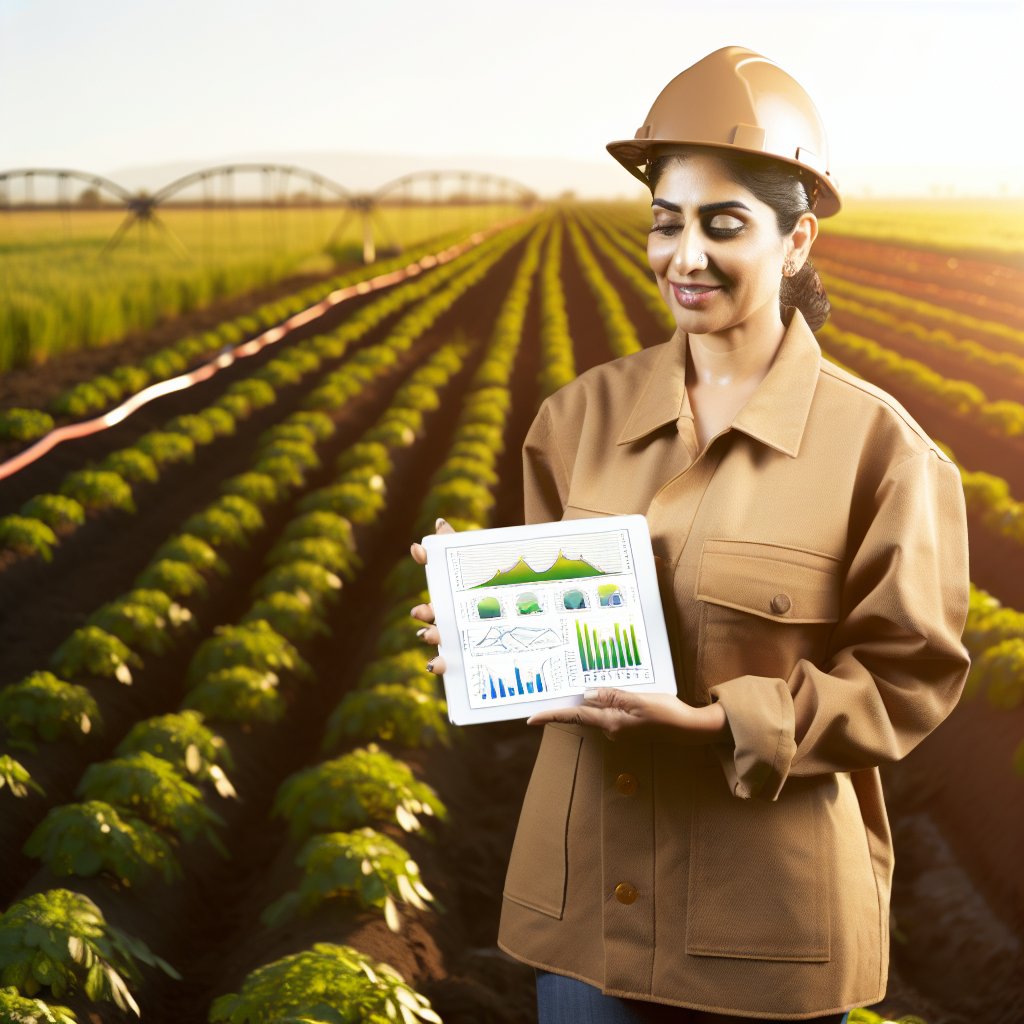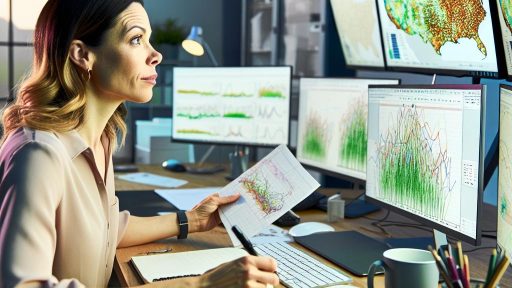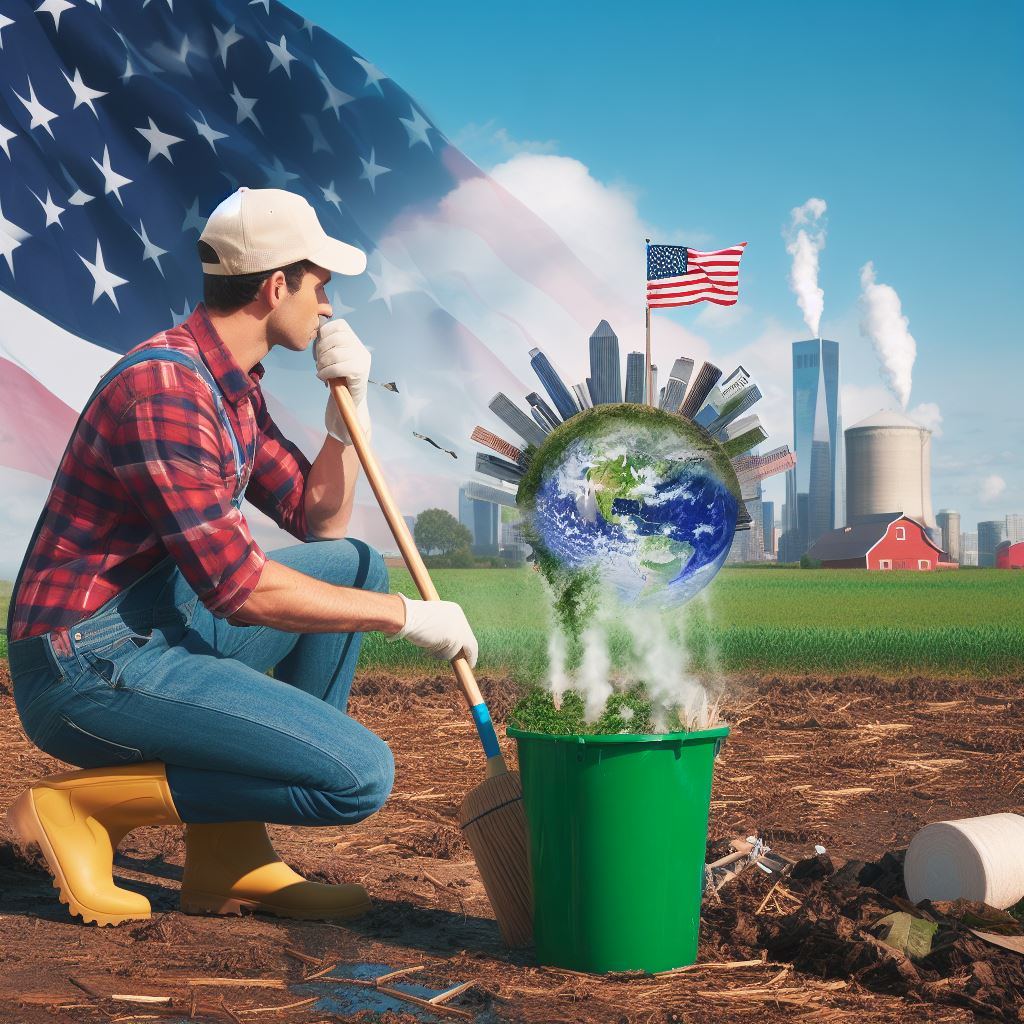Introduction to Smart Irrigation and Its Importance in Agriculture
Smart irrigation technology optimizes water usage in farming.
It increases crop yields while conserving precious water resources.
This method uses advanced sensors and automated systems.
Farmers can monitor soil moisture levels accurately.
Additionally, smart irrigation reduces wasteful water practices.
Enhancing Crop Production
Efficient water use directly impacts crop health and growth.
Smart irrigation ensures crops receive the right amount of water.
Under- and over-watering often leads to poor crop performance.
Thus, using technology maximizes overall agricultural productivity.
Conserving Water Resources
Freshwater scarcity is a growing global issue.
Smart irrigation systems significantly reduce water consumption.
These systems adapt to changing weather conditions automatically.
Moreover, they help prevent water loss through evaporation.
Economic Benefits for Farmers
Implementing smart irrigation can lead to substantial cost savings.
Reducing water usage directly lowers water bills.
Transform Your Agribusiness
Unlock your farm's potential with expert advice tailored to your needs. Get actionable steps that drive real results.
Get StartedFurthermore, increased efficiency can boost overall farm profits.
Investment in this technology often pays off quickly.
Supporting Environmental Sustainability
Smart irrigation promotes sustainable farming practices.
It minimizes groundwater depletion and soil erosion.
Moreover, healthy crops contribute to better air quality.
This method also fosters biodiversity by enhancing habitat conservation.
Overview of Traditional Irrigation Methods and Their Limitations
Common Irrigation Techniques
A variety of irrigation methods exist in agriculture.
Surface irrigation involves flooding fields with water.
This technique relies on gravity to distribute water.
Nevertheless, surface irrigation often leads to water loss through evaporation.
Drip irrigation delivers water directly to plant roots.
This method conserves water but requires complex systems.
Sprinkler systems mimic rainfall to evenly distribute water.
These systems can be costly to install and maintain.
Limitations of Traditional Methods
Traditional irrigation methods can be inefficient.
They often waste substantial amounts of water.
Evaporation and runoff significantly contribute to these losses.
Moreover, surface irrigation can lead to soil erosion.
This erosion depletes soil nutrients and structure.
Additionally, uneven distribution may leave some plants thirsty.
Often, traditional techniques do not account for specific plant needs.
Environmental Impacts
Traditional irrigation practices negatively affect local ecosystems.
Overwatering can lead to waterlogging and salinity issues.
This situation may render farmland unusable over time.
Showcase Your Farming Business
Publish your professional farming services profile on our blog for a one-time fee of $200 and reach a dedicated audience of farmers and agribusiness owners.
Publish Your ProfileConsequently, local water sources may deplete rapidly.
These impacts highlight the urgent need for better practices.
Principles of Smart Irrigation
Definition of Smart Irrigation
Smart irrigation refers to advanced techniques for optimizing water use.
This method utilizes technology to manage irrigation efficiently.
It combines elements of environmental science and agricultural practice.
By employing smart irrigation, farmers can maximize yields while conserving water.
Goals of Smart Irrigation
The primary goal is to reduce water consumption in agriculture.
Additionally, it aims to enhance crop health and productivity.
Smart irrigation systems seek to minimize waste and runoff.
Furthermore, they focus on making irrigation scheduling more precise.
This approach fosters sustainability in agricultural practices.
Key Components of Smart Irrigation
Smart irrigation systems often include sensor technology.
These sensors monitor soil moisture levels in real-time.
They also consider weather forecasts to adjust irrigation schedules.
Moreover, automated controllers help streamline water distribution.
Benefits of Implementing Smart Irrigation
Implementing smart irrigation offers significant water savings.
It also leads to reduced energy costs associated with irrigation.
Farmers experience improved crop yields due to better water management.
Additionally, smart systems can reduce labor costs for irrigation tasks.
Overall, smart irrigation enhances resilience to drought conditions.
Learn More: Maximizing Farmland ROI With Climate-Resilient Agriculture
Technological Innovations in Irrigation
Sensors and Their Applications
Sensors play a crucial role in modern irrigation systems.
They monitor soil moisture, temperature, and other environmental factors.
This data helps farmers make informed decisions about watering.
For instance, soil moisture sensors prevent overwatering.
As a result, farmers conserve water while optimizing crop health.
Internet of Things in Agriculture
The Internet of Things (IoT) connects various irrigation devices.
This connectivity allows real-time data sharing across systems.
Farmers can access valuable data from their smartphones or computers.
Through IoT, they can automate watering processes effectively.
Consequently, farmers save time and resources on irrigation management.
Automation of Irrigation Systems
Automation in irrigation enhances efficiency significantly.
Automated systems can adjust watering schedules based on weather forecasts.
For example, rain sensors can halt irrigation during rainfall.
This technology minimizes water wastage and conserves energy.
Moreover, automated systems can be programmed to operate at night.
Operating during cooler hours reduces evaporation rates significantly.
The Role of Drones in Irrigation Management
Drones are becoming essential tools for precision agriculture.
They provide aerial views of fields to assess irrigation needs.
Farmers can identify dry spots requiring additional water.
Showcase Your Farming Business
Publish your professional farming services profile on our blog for a one-time fee of $200 and reach a dedicated audience of farmers and agribusiness owners.
Publish Your ProfileDrones also monitor plant health and growth throughout the season.
This data helps optimize irrigation strategies effectively.
Advantages of Smart Irrigation Technologies
- Reduced water consumption through precise application.
- Improved crop yields due to better watering practices.
- Lower labor costs as automation takes over repetitive tasks.
- Increased sustainability and reduced environmental impact.
Farmers who adopt these technologies benefit from many advantages.
They not only enhance productivity but also protect vital water resources.
You Might Also Like: Drought and Flood Risks for Agricultural Real Estate Investors
Case Studies: Successful Implementation of Smart Irrigation Strategies
Introduction to Case Studies
Case studies provide valuable insights into successful smart irrigation strategies.
These real-world examples showcase innovation and efficiency in water management.
Moreover, they highlight the impacts on crop yields and sustainability.
Case Study: Green Valley Farms
Green Valley Farms implemented smart irrigation technology in California.
They used soil moisture sensors to optimize water application.
This resulted in a 30% reduction in water usage.
Furthermore, crop yields increased by 15% within the first year.
Overall, their profit margins improved significantly.
Technology Employed
The farm utilized advanced drip irrigation systems.
These systems delivered water directly to the root zones.
Additionally, they installed automated weather stations.
This allowed real-time adjustments based on weather conditions.
Key Takeaways
Efficient water use leads to higher profitability.
Regular monitoring ensures optimal irrigation practices.
Therefore, technology plays a key role in sustainable farming.
Case Study: Sunny Acres Farm
Sunny Acres Farm explored the benefits of rainwater harvesting.
They collected rainwater for irrigation purposes, reducing groundwater dependency.
This initiative improved their overall water management strategy.
As a result, they saved 25% on their annual water costs.
Implementation Details
Additionally, they integrated smart controllers for irrigation scheduling.
This technology ensured water was used efficiently across the entire farm.
Lessons Learned
Rainwater harvesting can significantly reduce costs.
It enhances resilience during drought conditions.
Moreover, it contributes to overall environmental sustainability.
Case Study: Riverbend Orchards
Riverbend Orchards adopted precision agriculture techniques.
They used drones to monitor crop health and soil moisture levels.
This innovative approach improved water management efficiency.
Subsequently, they increased their apple harvest by 20%.
Technological Advances
Drones provided real-time data on plant health and irrigation needs.
This information enabled precise watering and nutrient application.
As a result, the farm operated more sustainably and profitably.
Impacts of Precision Agriculture
Precision agriculture reduces water waste significantly.
It also minimizes the environmental impact of farming activities.
Consequently, farmers can achieve greater yields with less input.
Showcase Your Farming Business
Publish your professional farming services profile on our blog for a one-time fee of $200 and reach a dedicated audience of farmers and agribusiness owners.
Publish Your ProfileUncover the Details: The Impact of Climate Change on Irrigation and Sustainable Farming
Water-Saving Techniques: Drip Irrigation vs. Sprinkler Systems
Overview of Drip Irrigation
Drip irrigation delivers water directly to the plant roots.
This method minimizes water loss through evaporation.
It uses a network of tubing and emitters to control water flow.
Moreover, drip irrigation is highly efficient for various crops.
Farmers can set it on timers for automated watering.
Advantages of Drip Irrigation
Drip irrigation significantly reduces water usage.
It can lead to substantial cost savings over time.
Additionally, it helps prevent soil erosion and nutrient runoff.
This system supports healthier crop growth through consistent moisture.
Challenges of Drip Irrigation
Installation can be more complex and costly than other systems.
Furthermore, maintenance requires regular checks for clogs.
Farmers may need training to manage it effectively.
Overview of Sprinkler Systems
Sprinkler systems distribute water like rainfall.
They cover large areas efficiently and are easy to install.
These systems can be stationary or mobile.
Moreover, they work well for various terrains and crops.
Advantages of Sprinkler Systems
Sprinkler systems provide flexible watering options for farmers.
They are generally easier to set up compared to drip systems.
Additionally, they can serve multiple fields simultaneously.
This method is ideal for larger farms wanting quick coverage.
Challenges of Sprinkler Systems
Sprinklers can waste water through evaporation and drift.
Wind can also affect their efficiency during watering.
Moreover, they may not deliver water directly to roots.
Comparative Analysis
Choosing between drip irrigation and sprinkler systems depends on the specific needs of the farm.
Drip irrigation excels in water conservation and target watering.
Conversely, sprinklers offer convenience and broader coverage.
Both methods can be effective, but their suitability varies.
Ultimately, factors such as crop type, terrain, and budget influence the decision.
Discover More: Sustainable Farming Practices for Real Estate Landowners

Role of Weather Forecasting and Data Analytics in Irrigation Management
Importance of Weather Forecasting
Weather forecasting plays a crucial role in effective irrigation management.
Accurate weather predictions help farmers determine the optimal watering schedule.
They can anticipate rainy days and adjust irrigation accordingly.
This strategy prevents overwatering and minimizes water waste.
Enhancing Decision-Making with Data Analytics
Data analytics further improves irrigation management efficiency.
Farmers can analyze historical weather patterns to make informed decisions.
By processing large datasets, they identify trends affecting water needs.
This analysis helps in optimizing water usage across different crops.
Integration of Technology in Irrigation
Modern technology streamlines the irrigation process significantly.
Sensors measure soil moisture levels in real time.
Showcase Your Farming Business
Publish your professional farming services profile on our blog for a one-time fee of $200 and reach a dedicated audience of farmers and agribusiness owners.
Publish Your ProfileThis allows for precise watering based on actual crop needs.
Additionally, automated irrigation systems respond to weather forecasts.
Benefits of Combining Forecasting and Analytics
The combination of weather forecasting and data analytics offers substantial advantages.
These methods empower farmers to increase their water efficiency.
They lead to improved crop yields while conserving vital resources.
Ultimately, this results in a more sustainable agricultural practice.
Case Studies of Successful Implementation
Several farms have benefitted from these advanced strategies.
A local vineyard used weather data to adjust its irrigation schedule.
This led to a 20% reduction in water consumption.
Another farm reported improved yield quality through data-driven decisions.
Such success stories illustrate the potential of these technologies.
Benefits of Smart Irrigation
Economic Advantages
Smart irrigation systems significantly reduce water costs for farmers.
By optimizing water usage, farmers can increase their profit margins.
Additionally, these systems reduce labor costs through automation.
Farmers can allocate resources more effectively, enhancing overall productivity.
Investing in technology leads to long-term savings for agricultural operations.
Environmental Benefits
Smart irrigation plays a critical role in conserving water resources.
These systems minimize water waste, which helps sustain local water supplies.
Furthermore, they reduce runoff, decreasing soil erosion and nutrient loss.
Deploying advanced sensor technology lowers the chemical runoff into waterways.
Ultimately, smart irrigation fosters a healthier ecosystem for future generations.
Enhancements to Crop Health
With precise water delivery, smart irrigation improves crop growth consistency.
These systems help maintain optimal soil moisture levels for various crops.
Consistent watering contributes to healthier root systems and increased yields.
Moreover, plants receive essential nutrients more effectively through efficient irrigation.
Consequently, crop resilience to pests and diseases improves significantly.
Challenges and Solutions in Adopting Smart Irrigation Technologies
Identifying Key Challenges
Farmers face many challenges when adopting smart irrigation technologies.
High initial costs are often a significant barrier to entry.
Additionally, farmers may struggle with limited technical knowledge.
Compatibility with existing systems also presents challenges.
Lastly, unreliable internet connectivity can hinder progress.
Addressing Financial Constraints
Government incentives can help reduce financial barriers.
Subsidies may make smart irrigation systems more affordable.
Furthermore, grants and low-interest loans can encourage adoption.
Farmers can explore partnerships with tech companies for shared costs.
Tackling Knowledge Gaps
Education plays a vital role in overcoming knowledge gaps.
Workshops can provide hands-on training for farmers.
Online resources and tutorials are also beneficial for learning.
In addition, mentorship programs can help pair experienced farmers with beginners.
Enhancing System Compatibility
Choosing modular systems can improve compatibility with existing setups.
Showcase Your Farming Business
Publish your professional farming services profile on our blog for a one-time fee of $200 and reach a dedicated audience of farmers and agribusiness owners.
Publish Your ProfileFarmers should prioritize products that offer integration options.
Vendors can assist in customizing solutions for specific needs.
Regular updates from manufacturers can enhance system performance over time.
Improving Internet Connectivity
Investing in reliable internet infrastructure is essential for smart farming.
Farmers can collaborate with local governments to boost connectivity.
Utilizing satellite technology may also be a feasible solution.
Moreover, offline capabilities can provide a helpful backup plan.
Future Trends in Smart Irrigation for Sustainable Agriculture
Integration of Technology
Technology will reshape irrigation practices in the coming years.
Farmers increasingly adopt smart sensors and IoT devices.
These tools enhance real-time irrigation management.
Furthermore, they enable precise data collection on soil moisture.
Consequently, farmers can make informed watering decisions.
Adoption of Artificial Intelligence
Artificial intelligence will revolutionize irrigation systems.
AI algorithms analyze data and forecast irrigation needs.
This leads to optimized water delivery.
Moreover, it minimizes waste across various agricultural sectors.
As a result, yields will improve while conserving resources.
Shift Towards Sustainability
Sustainability remains a primary focus in agriculture.
Farmers are prioritizing water-efficient techniques.
Rainwater harvesting systems are becoming more commonplace.
Additionally, farmers are exploring drought-resistant crops.
These strategies significantly reduce overall water usage.
Collaboration and Community Practices
Collaboration among farmers enhances smart irrigation practices.
Communities share resources and knowledge through workshops.
This fosters a culture of innovation and sustainability.
Such partnerships often lead to shared technology investments.
As a result, collective efforts amplify water conservation efforts.
Government Support and Regulations
Government policies increasingly support smart irrigation initiatives.
Subsidies for technology adoption encourage farmers to switch.
Regulations promote sustainable practices at all levels.
Consequently, funding for research and development rises.
This ensures that advancements continue to emerge in agriculture.
Additional Resources
Digital technologies for water use and management in agriculture …
Biden-Harris Administration Invests Up to $400 Million to Address …




